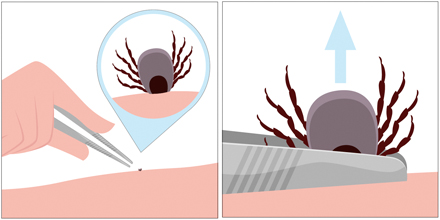Always remove ticks quickly! The longer the tick is attached to your skin, the higher the risk that it will transmit diseases.
What should I do if I have a tick bite?
Always remove the tick as soon as possible! The longer the tick is attached to your skin, the higher the risk that it will transmit diseases.
Do not use alcohol, iodine, oil or any other substance before removing the tick.
Use pointed tweezers to grasp the tick’s head as closely as possible to the skin and gently pull it out. A small piece of the head that is left embedded in the skin is nothing to worry about. It will fall out on its own, just like a splinter. Now disinfect the bite wound. Are you using a different type of tick remover? Follow the instructions that came with it.
Note when and where on your body you were bitten. Keep checking the skin around the tick bite for three months after the bite occurred. Look out for any discolouration of the skin or other symptoms associated with Lyme disease.
When to see a doctor
Go see your GP if you have one or more of these symptoms after a tick bite:
- Expanding discolouration of the skin at the location of the tick bite. This ‘ring’ around that spot can appear for up to three months after a tick bite.
- Fever, possibly accompanied by muscle ache and joint pain, in the first weeks after the bite.
- Joint problems, skin conditions, nervous complaints or cardiac symptoms may sometimes develop. This can occur if early symptoms of Lyme disease were not treated with antibiotics. However, these symptoms may also be the first signs of the disease.
Both the early and the later stages can be treated with antibiotics. However, if it progresses to a later stage, the infection may have already caused damage. For that reason, it is important to contact your GP if you have these symptoms.
Not sure about whether your tick bite is showing discolouration? Look at the examples on www.tekenradar.nl or the ‘Tekenbeet’ app.
Video: Removing ticks (in Dutch)
Heb je een teek?
Haal deze zo snel mogelijk weg met een puntige pincet of een speciale tekenverwijderaar!
Gebruik je een puntige pincet?
Pak de teek dan zo dicht mogelijk op de huid vast bij zijn kop.
Trek de teek er vervolgens rustig en in een rechte beweging uit.
Gebruik je een speciale tekenverwijderaar?
Volg dan de meegeleverde gebruiksaanwijzing.
Noteer de datum waarop je gebeten bent en maak een foto van de plek waar je gebeten bent.
Na het verwijderen van een teek zie je vaak een rood vlekje van de beet.
Dit vlekje is meestal een paar dagen zichtbaar.
Maar blijf de plek van de beet nog 3 maanden controleren!
Onstaat er in die periode een ring of vlek, neem dan contact op met je huistarts.
Ga ook naar de huisarts als je in de weken na de beet last krijgt van koorts, spierpijn of gewrichtspijn.
Meer weten?
Ga naar rivm.nl/tekenbeet
Do you have a tick?
Remove it as soon as possible using pointed tweezers or a special tick remover!
Are you using pointed tweezers?
Grasp the tick as closely as possible to the skin, holding it by the head.
Then gently pull the tick out without twisting.
Are you using a special tick remover?
Follow the instructions that came with it.
Make a note of the date when you were bitten and take a photo of the location of the tick bite.
After removing the tick, you will often see a red spot at the bite location.
The spot usually remains visible for several days.
Keep checking the bite location for 3 months!
If you develop a ring or spot at the location within those 3 months, contact your GP.
Also see your GP if you develop fever, muscle pain or joint pain within a few weeks of the tick bite.
Would you like to know more? Go to rivm.nl/tekenbeet
